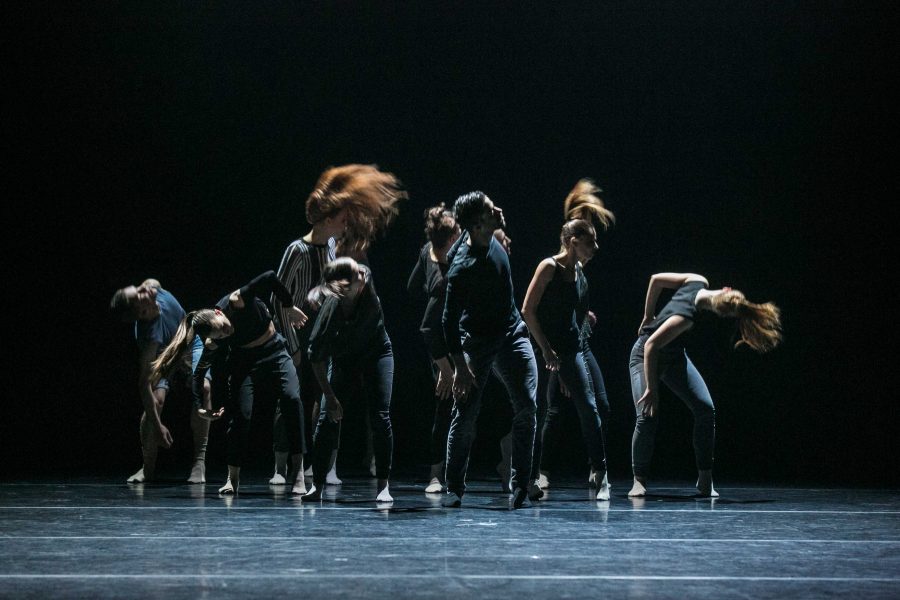W.A.R. (we are rats)
Táncolják: Várnagy Kristóf, Horváth Zita, Jurák Bettina, Szőllősi Krisztina, Földesi Milán, Szóka Roland, Varga Lotti, Nagy Nikolett, Raj Martin, Takács Odett, Hoffman Virág Zoé
Fény: Katonka Zoltán
Koreográfus asszisztens: Katonka Zoltán
Produkciós vezető: Barta Dóra
Koreográfus: Elias Lazaridis
Tartson velünk a programozott patkányok laboratóriumába! A programozott patkány egy átlagos képességű állat, azzal a különbséggel, hogy tudósok elektródákatültettek be a rágcsáló agyába, az érzékelő és az agyi jutalomközpont területeire. Így a patkányt egy távirányítóval irányítható, programozható. A programozott állat olyan különlegességeket is végrehajt, mint a létrára mászás, és olyan dolgokat is megtesz,amit alaphelyzetben a patkányok nem szeretnek, mint például leugrani nagy magasságokból. A hadsereg és különféle társaságok élénken érdeklődnek a programozott patkány után, remélve, hogy hasznosnak bizonyulnak: felfedezhetik az összeomlott épületek alá ragadt túlélőket, megtalálhatják a bombákat vagy feltérképezhetik a földalatti alagutakat és barlangokat. Az állatvédők szerint mindez szenvedést okoz a kísérleti alanyoknak. Sanjiv Talwar a New York-i egyetem professzora, a programozott patkány kísérletek egyik vezető kutatója visszautasítja ezt a vádat. Azzal érvel, hogy a patkányok élvezik a kísérletet. Ugyanis amikor a programozott patkány végrehajtja a számára kijelölt feladatot, akkor a beépített elektródákkal stimulálják az agyi jutalomközpontot, s ilyenkor a patkányjóleső érzést, tulajdonképpen boldogságot él át. Ezen túlmenően a patkányok egyáltalán nem érzik azt, hogy nem a saját akaratukból cselekszenek, hogy kívülről kényszeríti őket bárki az elvégzendő feladatokra. A programozott agyuk diktál, amit viszont beépített elektródák stimulálnak, amelyek egyenesen Sanjiv Talwar professzor távirányítójától kapják a parancsot. Ugyanakkor, ha a patkányokat kérdeznénk erről, akkor valószínűleg azt mondanák: „Biztos vagyok benne, hogy nekem szabad akaratom van! Nézd, ha balra akarok fordulni, hát balra fordulok. Ha fel akarok mászni a létrára, akkor felmászok a létrára. Mi sem bizonyítja ettől jobban, hogy szabad akaratom van?”
ENG.
W.A.R. (we are rats)
Dancers: Várnagy Kristóf, Horváth Zita, Szőllősi Krisztina, Szóka Roland, Jurák Bettina, Földesi Milán, Varga Lotti, Nagy Nikolett, Takács Odett, Raj Martin, Hoffman Virág Zoé
Light designer: Zoltán Katonka
Assistant choreographer: Zoltan Katonka
Executive producer: Dora Barta
Choreographer: Elias Lazaridis
W.A.R. ( we are rats )A choreography and concept by Elias Lazaridis“If you want to see philosophy in action, pay a visit to a robo-rat laboratory. Arobo-rat is a run-ofthe-mill rat with a twist: scientists have implantedelectrodes into the sensory and reward areas in the rat’s brain. This enablesthe scientists to manoeuvre the rat by remote control. After short trainingsessions, researchers have managed not only to make the rats turn left orright, but also to climb ladders, sniff around garbage piles, and do things thatrats normally dislike, such as jumping from great heights. Armies andcorporations show keen interest in the robo-rats, hoping they could proveuseful in many tasks and situations. For example, robo-rats could help detectsurvivors trapped under collapsed buildings, locate bombs and booby traps,and map underground tunnels and caves. Animal-welfare activists havevoiced concern about the suffering such experiments inflict on the rats.Professor Sanjiv Talwar of the State University of New York, one of theleading robo-rat researchers, has dismissed these concerns, arguing that therats actually enjoy the experiments. After all, explains Talwar, the rats ‘work for pleasure’ and when the electrodes stimulate the reward centre in their brain, ‘the rat feels Nirvana’.To the best of our understanding, the rat doesn’t feel that somebody elsecontrols her, and she doesn’t feel that she is being coerced to do somethingagainst her will. When Professor Talwar presses the remote control, the ratwants to move to the left, which is why she moves to the left. When theprofessor presses another switch, the rat wants to climb a ladder, which iswhy she climbs the ladder. After all, the rat’s desires are nothing but a patternof firing neurons. What does it matter whether the neurons are firing becausethey are stimulated by other neurons, or because they are stimulated bytransplanted electrodes connected to Professor Talwar’s remote control? Ifyou asked the rat about it, she might well have told you, ‘Sure I have free will!Look, I want to turn left –and I turn left. I want to climb a ladder –and I climba ladder. Doesn’t that prove that I have free will?”― Yuval Noah Harari, Homo Deus: A Brief History of Tomorrow.
II.rész
IN MY ROOM
Táncolják: Várnagy Kristóf, Horváth Zita, Szőllősi Krisztina, Szóka Roland, Jurák Bettina, Földesi Milán, Varga Lotti, Nagy Nikolett, Takács Odett, Raj Martin, Hoffman Virág Zoé
Fény: Katonka Zoltán
Produkciós vezető: Barta Dóra
Koreográfus: Nicola Monaco
Az In My Room olyan témákat érint, mint a hedonizmus, szabadság, és az elszakadás iránti vágy. Ehhez inspirációt merít az underground party kultúra, és a ‘70-es évek legendás new yorki clubja, a Studio 54 világából, megidézve egy olyan teret, ahol a lüktető zenében összeolvad (hét) test, és lélek/elme.
ENG
IN MY ROOM
Dancers: Várnagy Kristóf, Horváth Zita, Szőllősi Krisztina, Szóka Roland, Jurák Bettina, Földesi Milán, Varga Lotti, Nagy Nikolett, Takács Odett, Raj Martin, Hoffman Virág Zoé
Light designer: Zoltán Katonka
Executive producer: Dora Barta
Choreographer: Nicola Monaco
Inspired by the underground techno club scene and the 70’s phenomenon of studio 54 in New York, ‘IN MY ROOM’ explores subjects such as hedonism, freedom and escapism inside a box where the prominent beat of the techno music connects seven bodies and minds.







